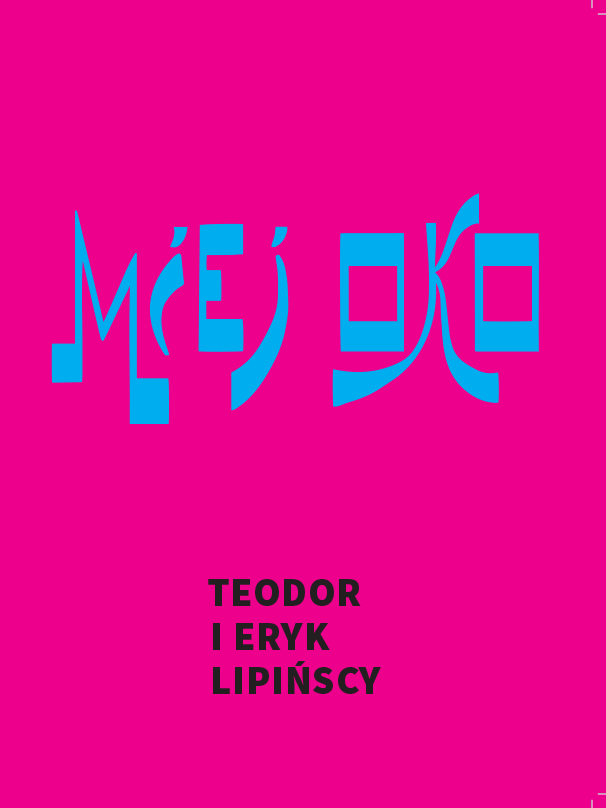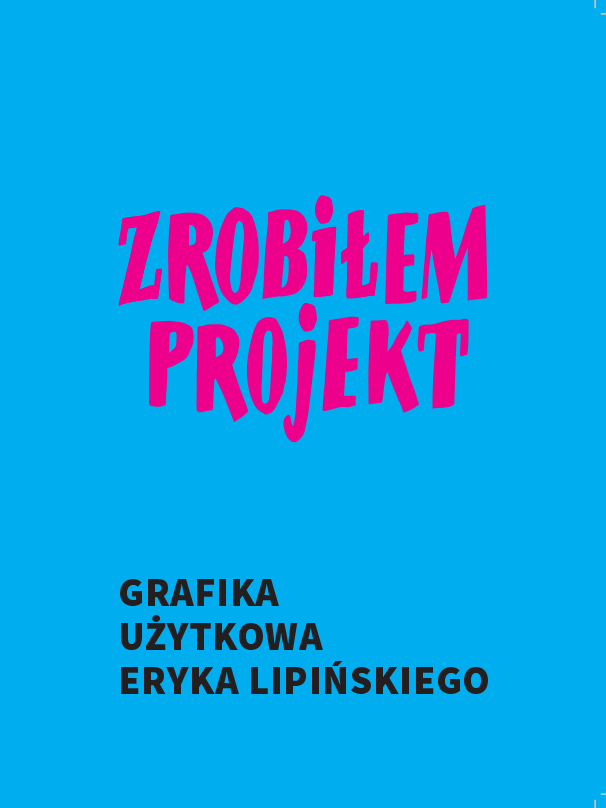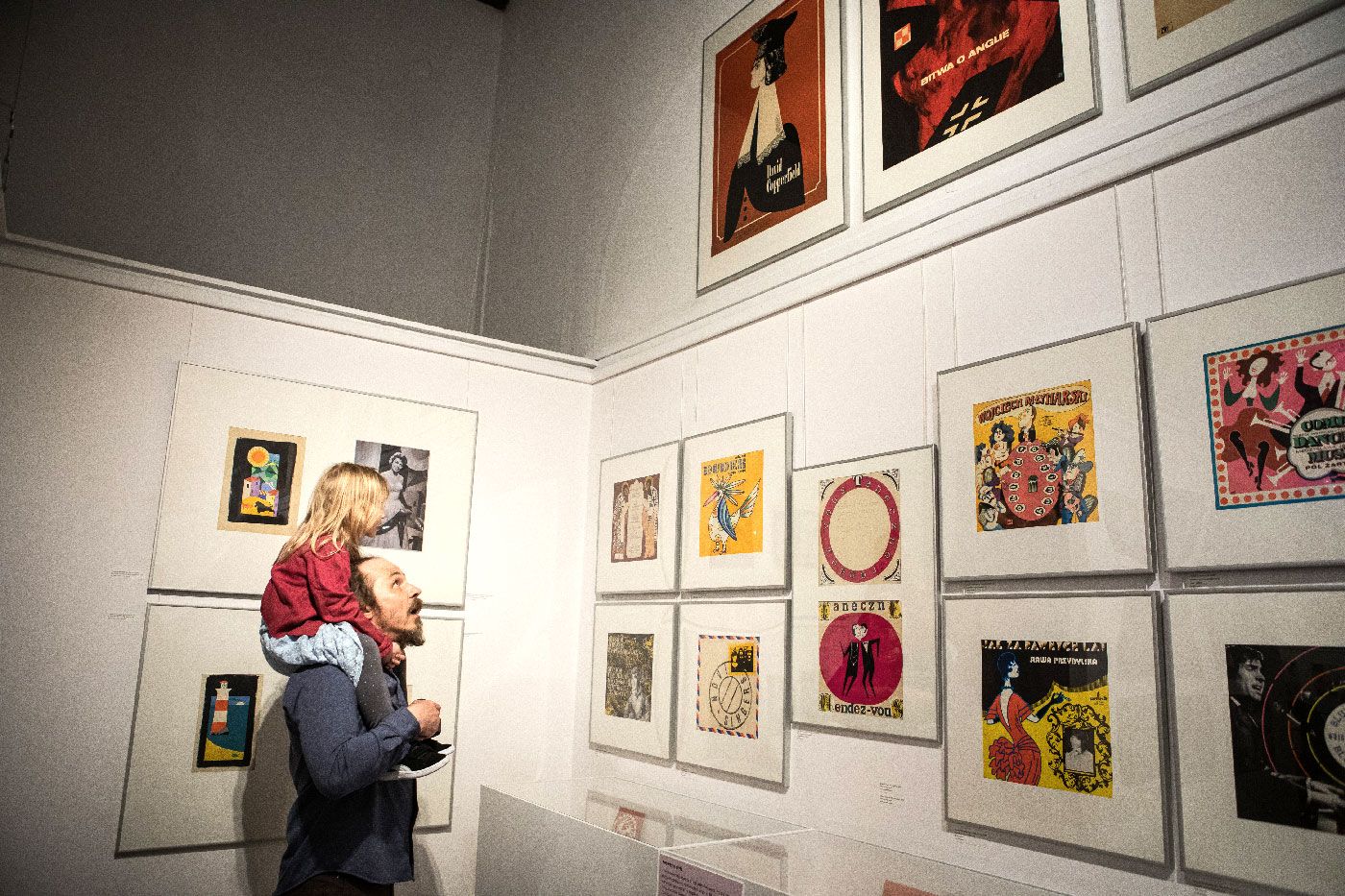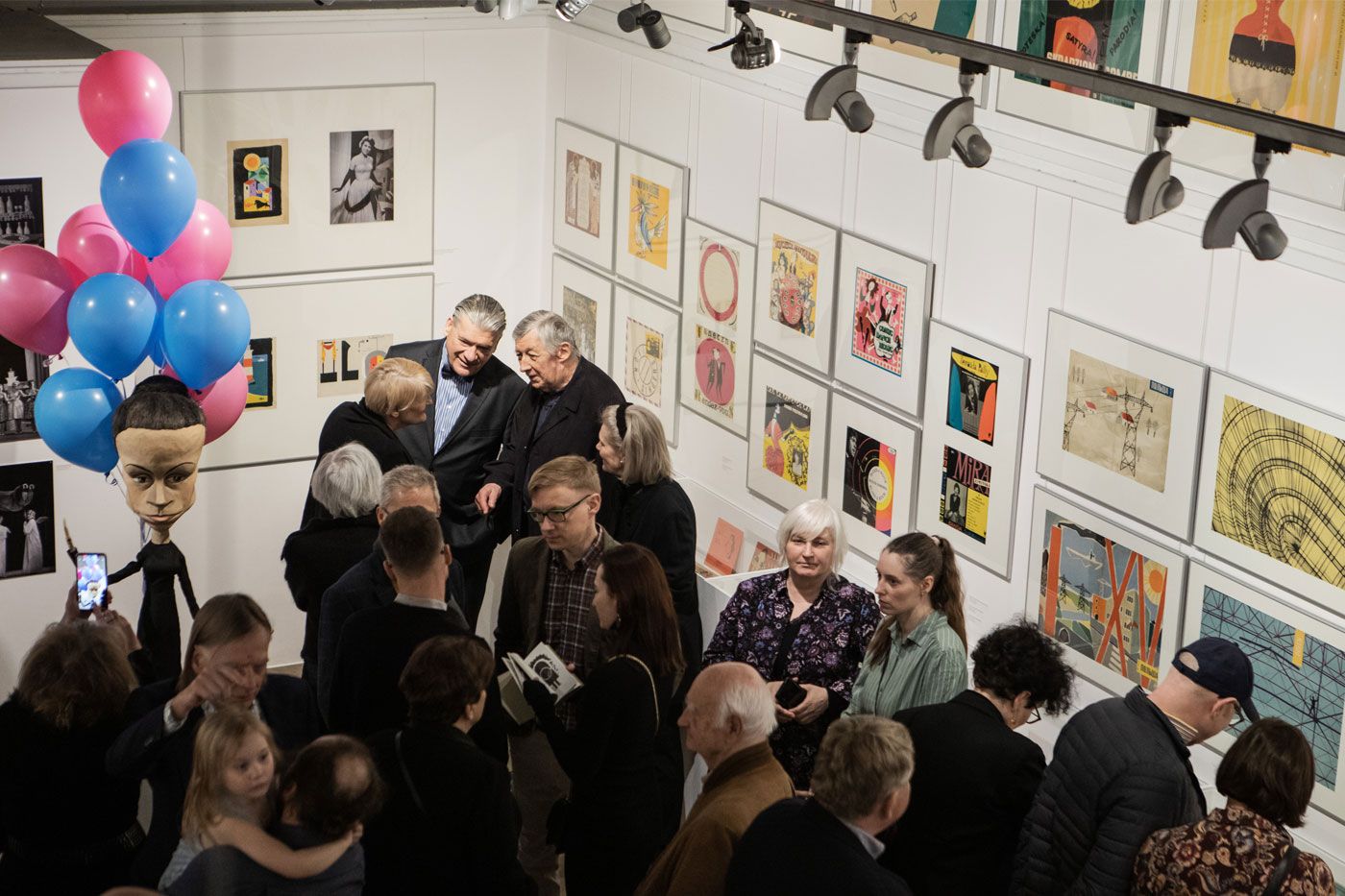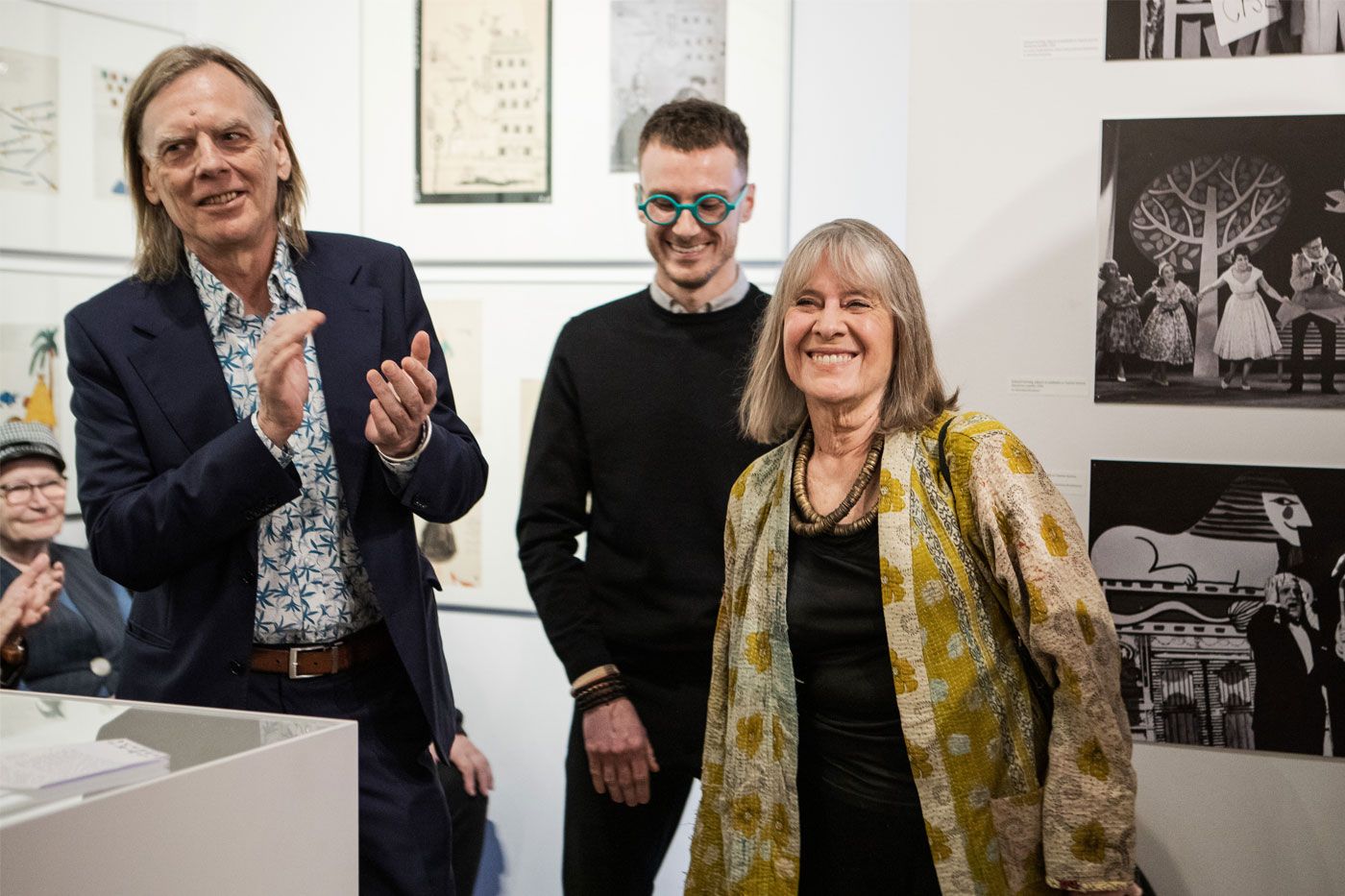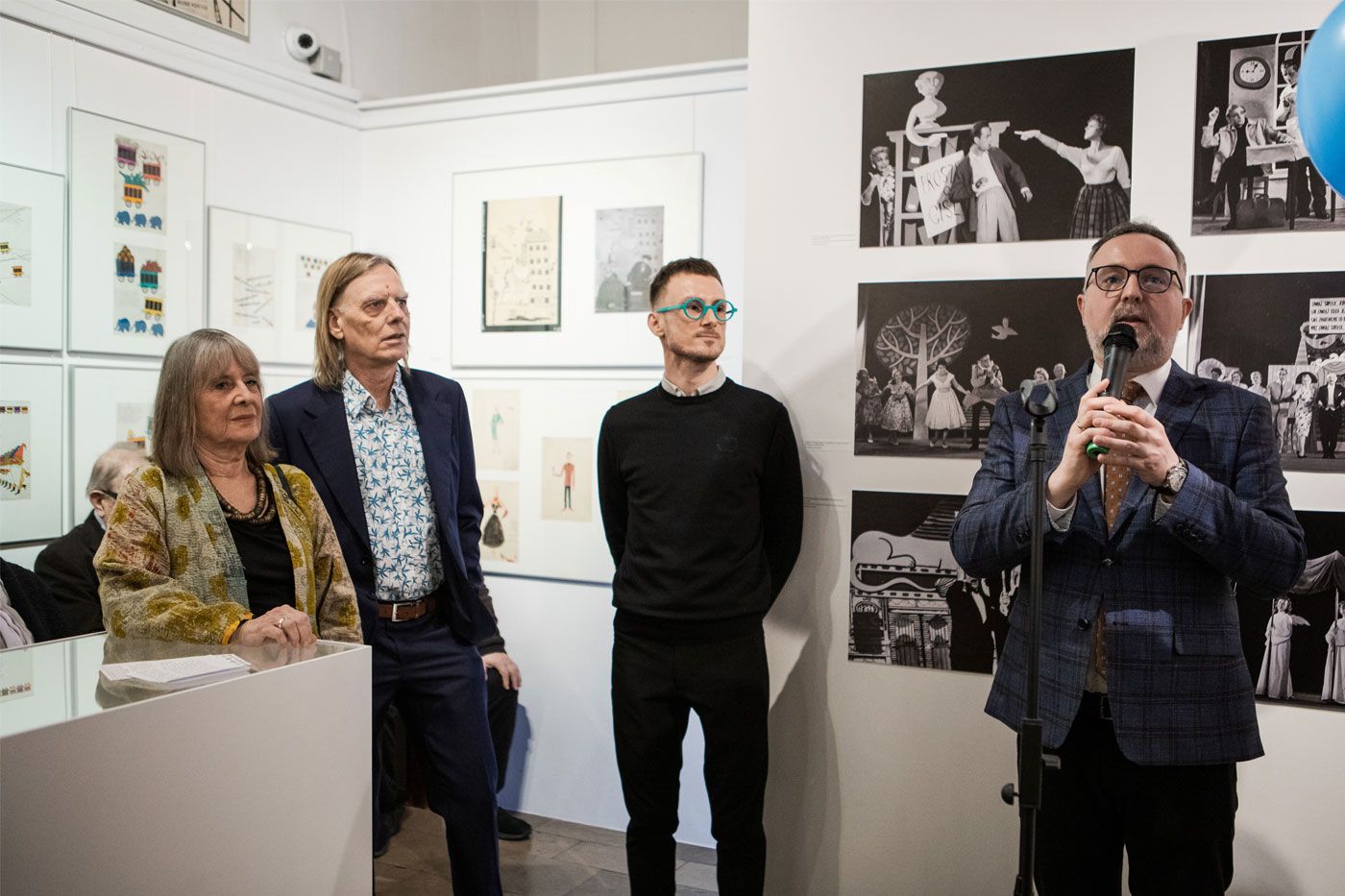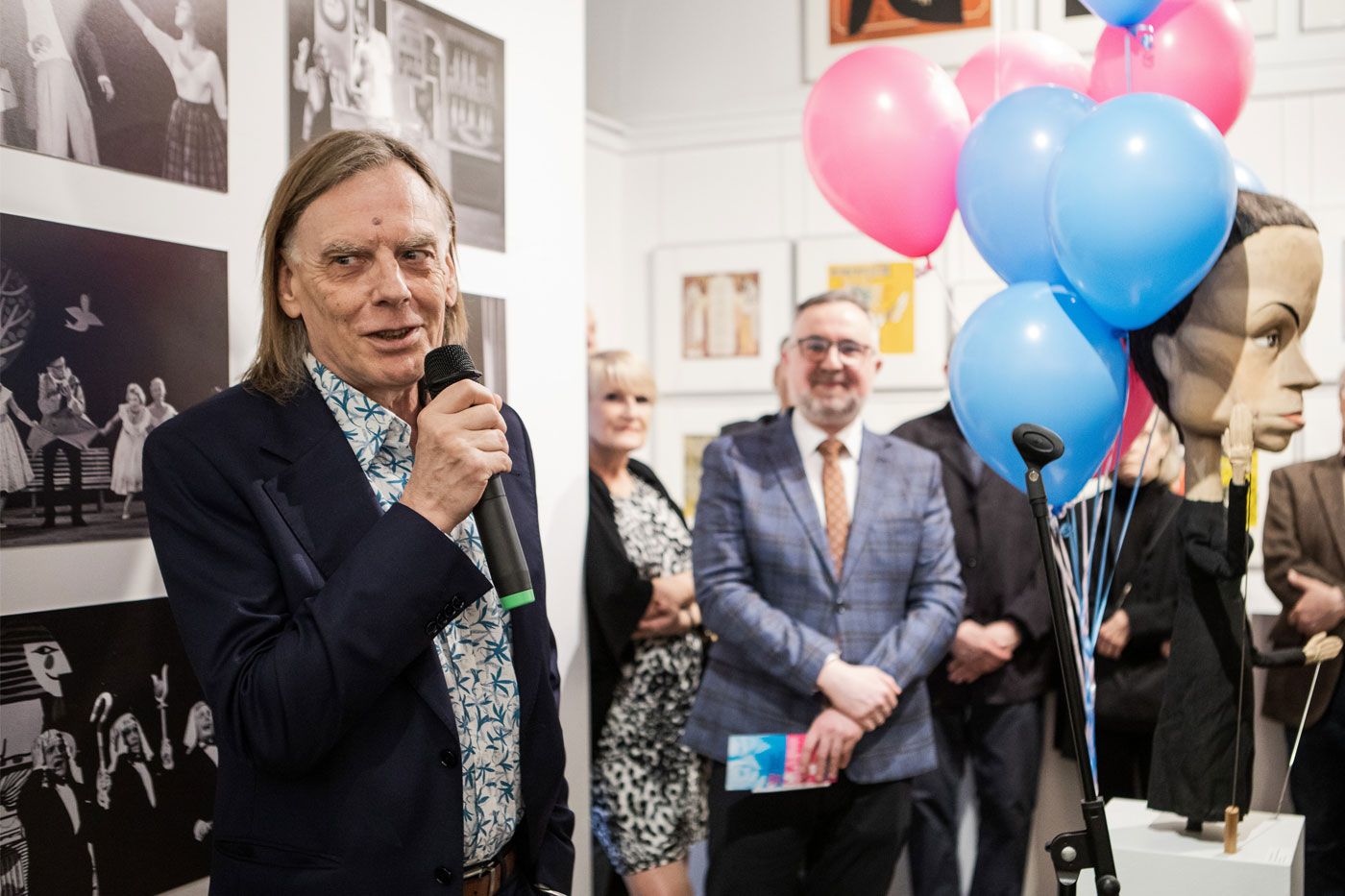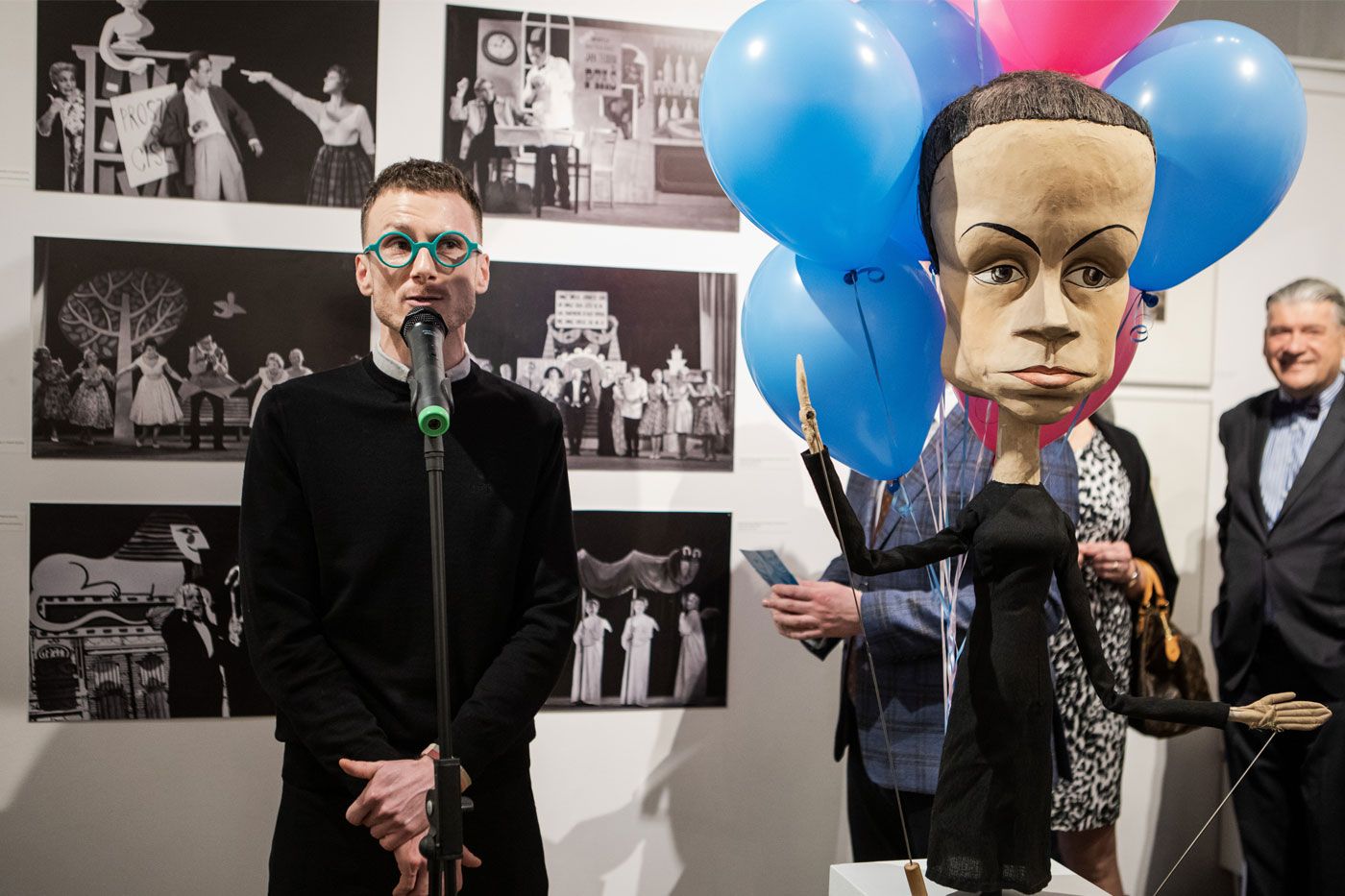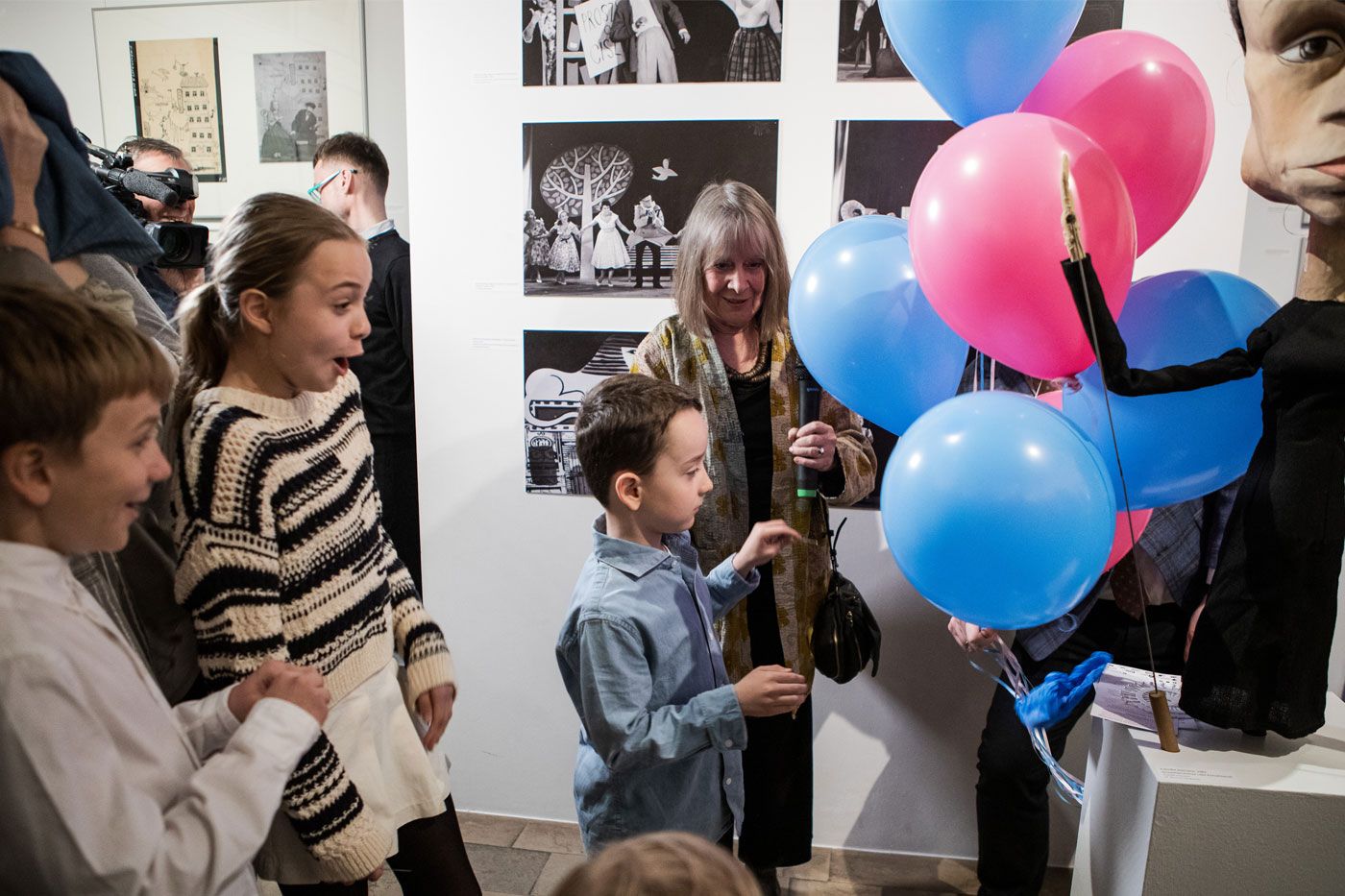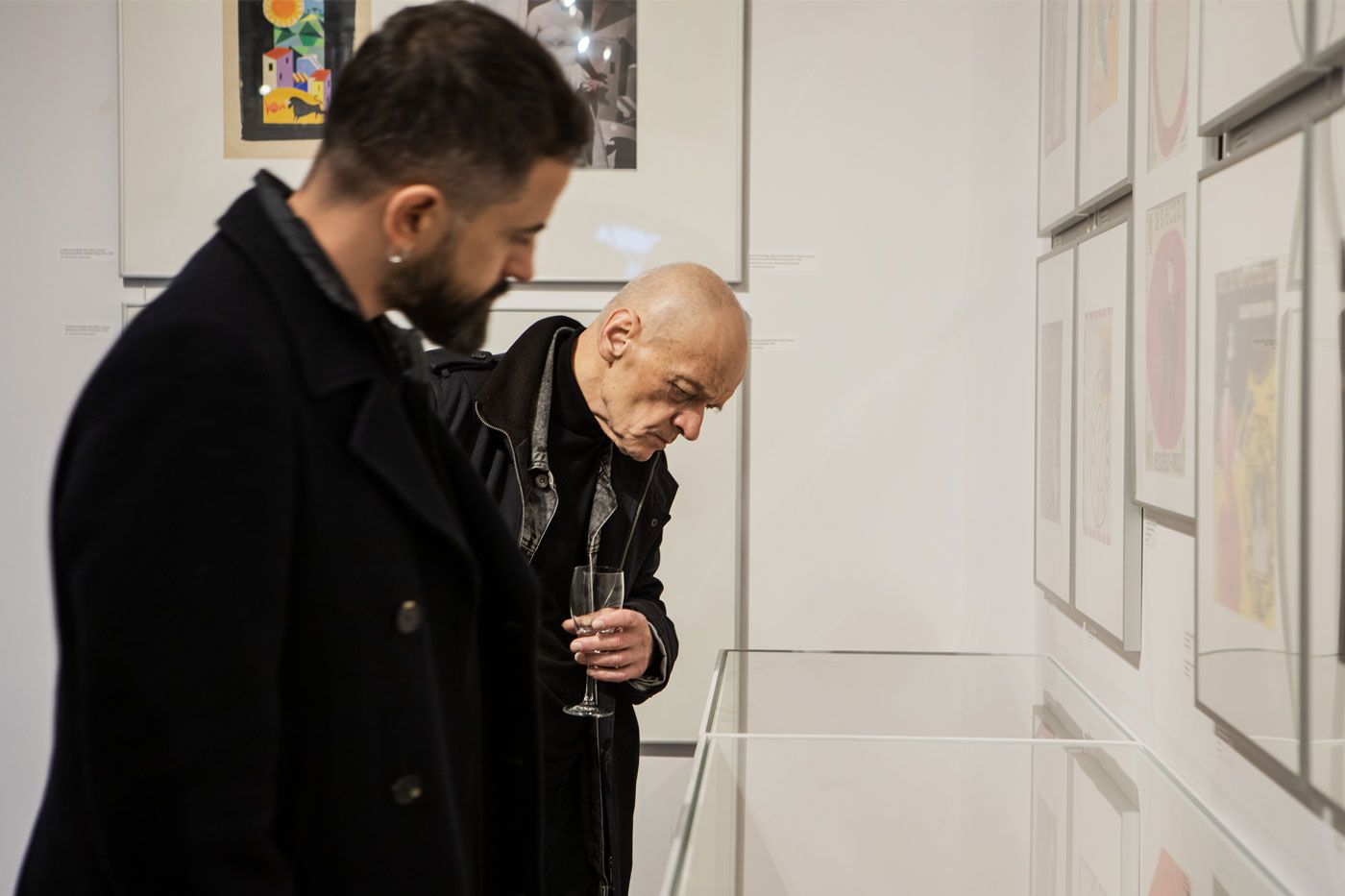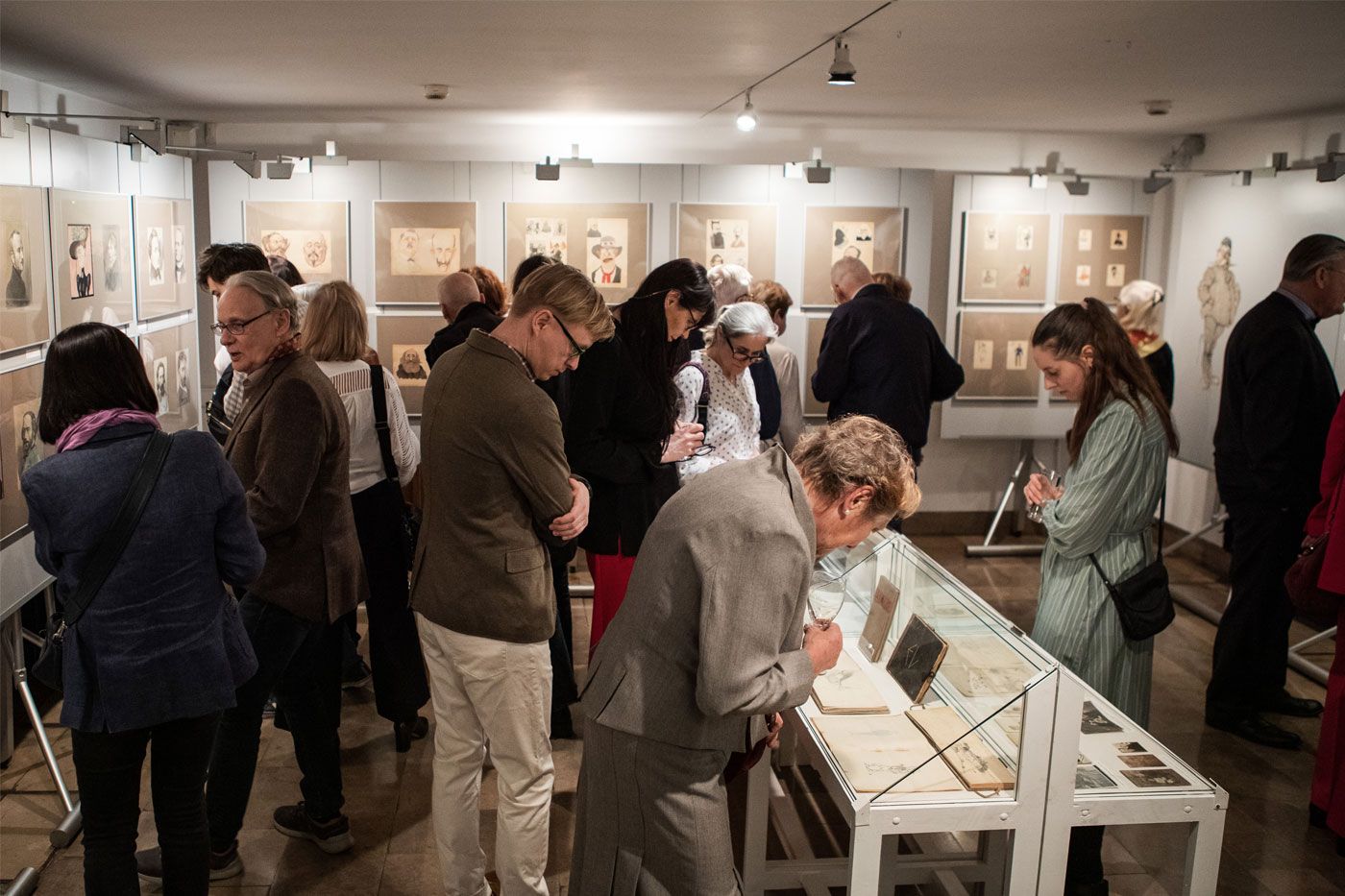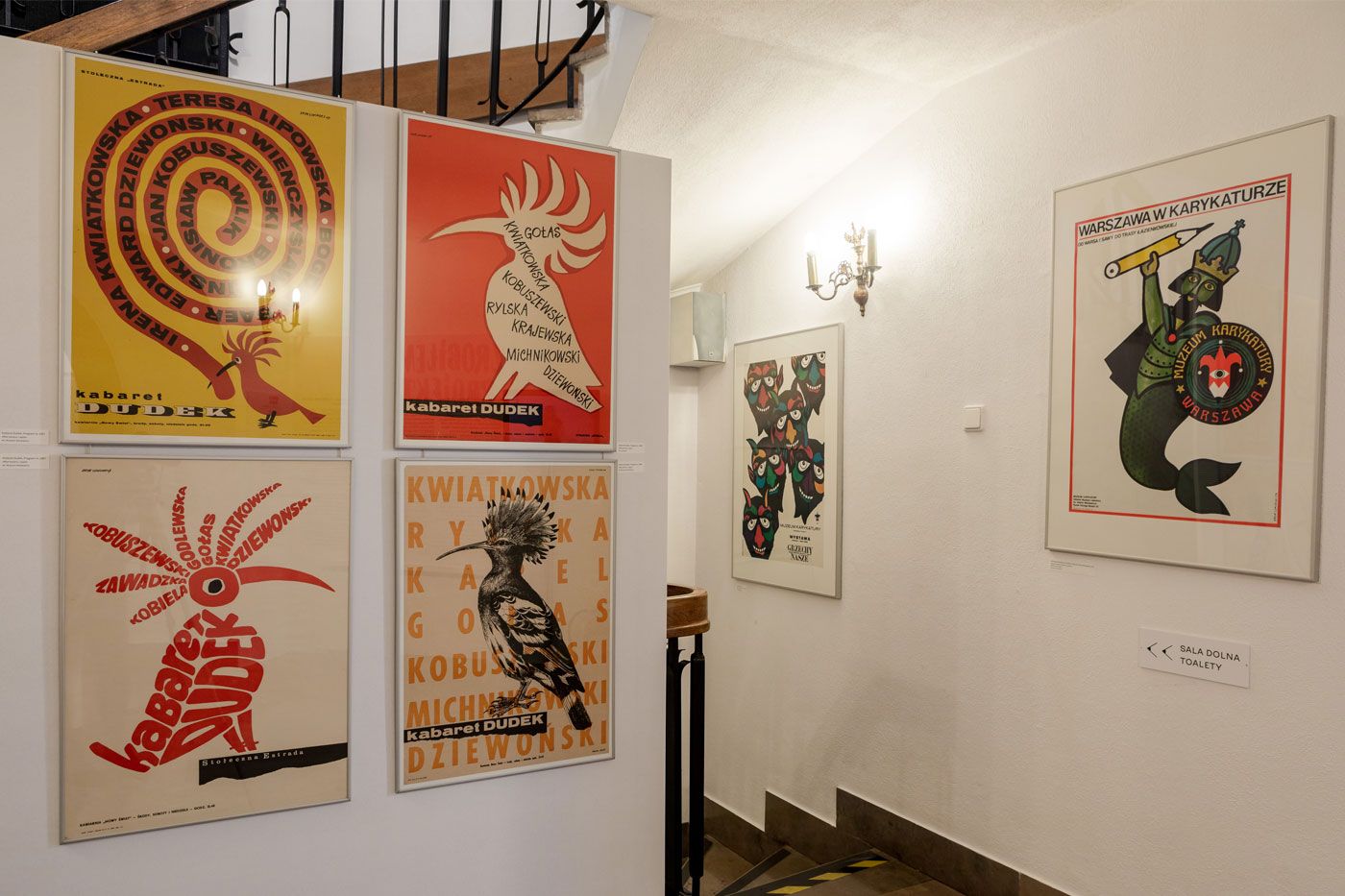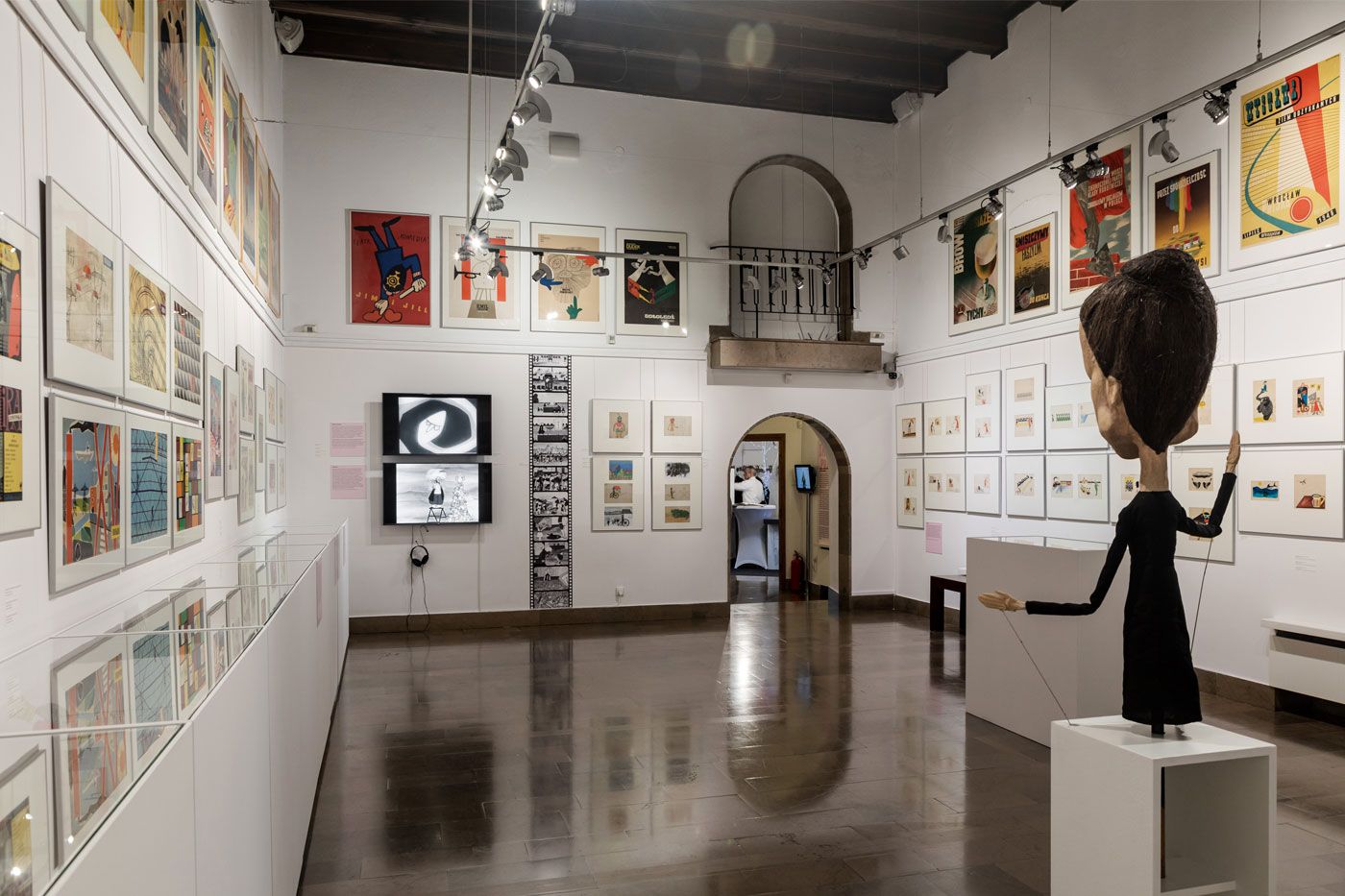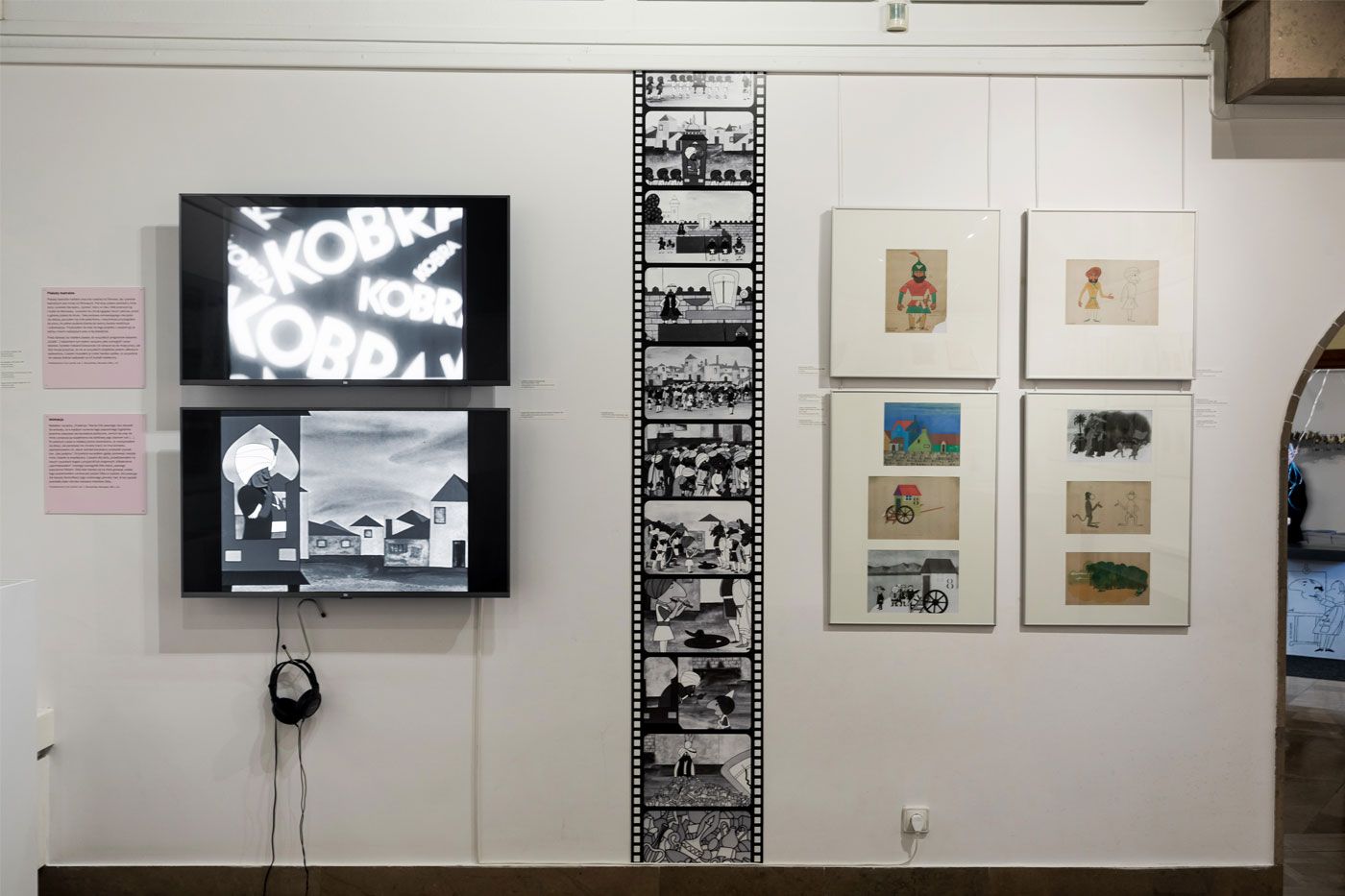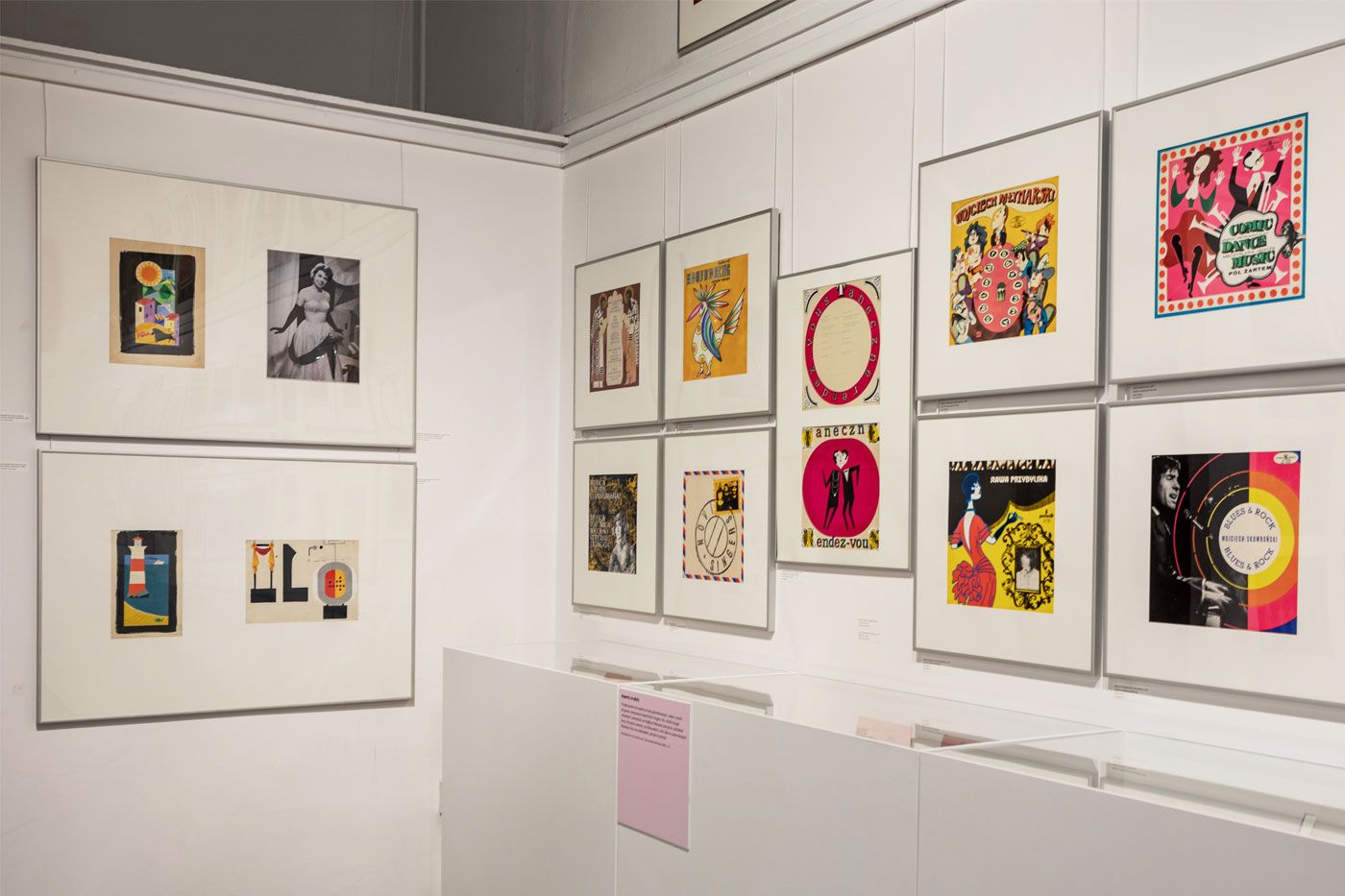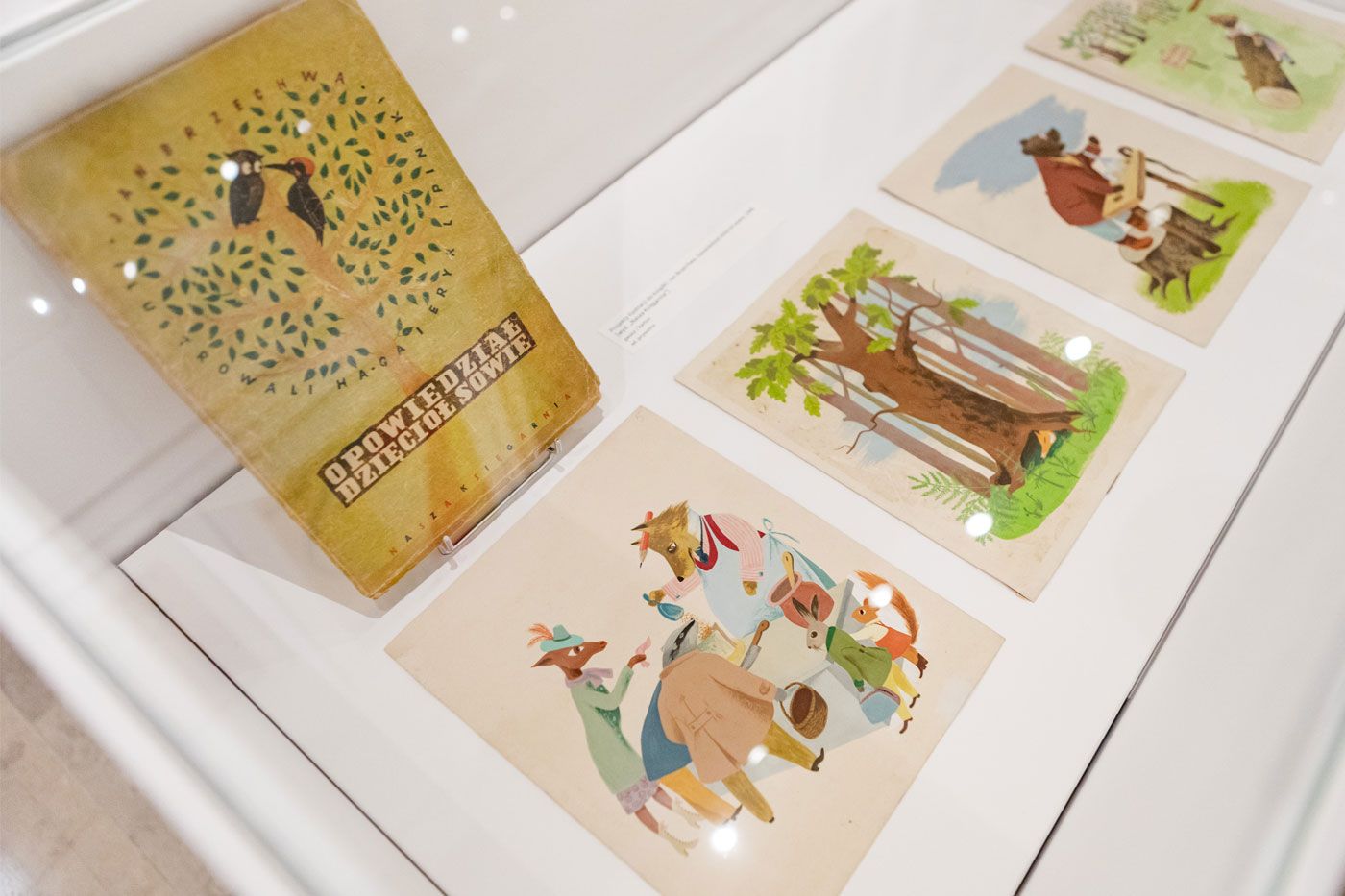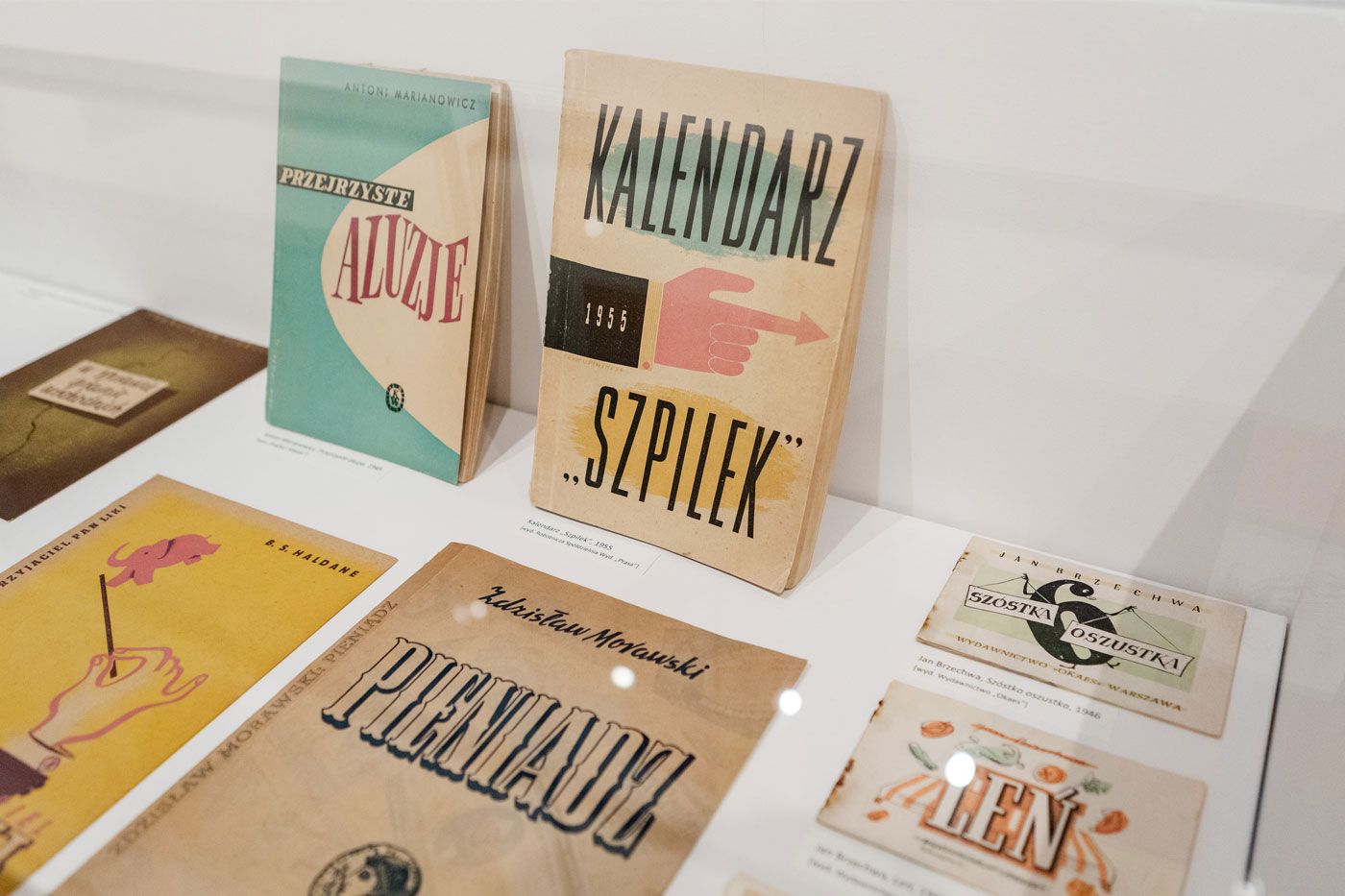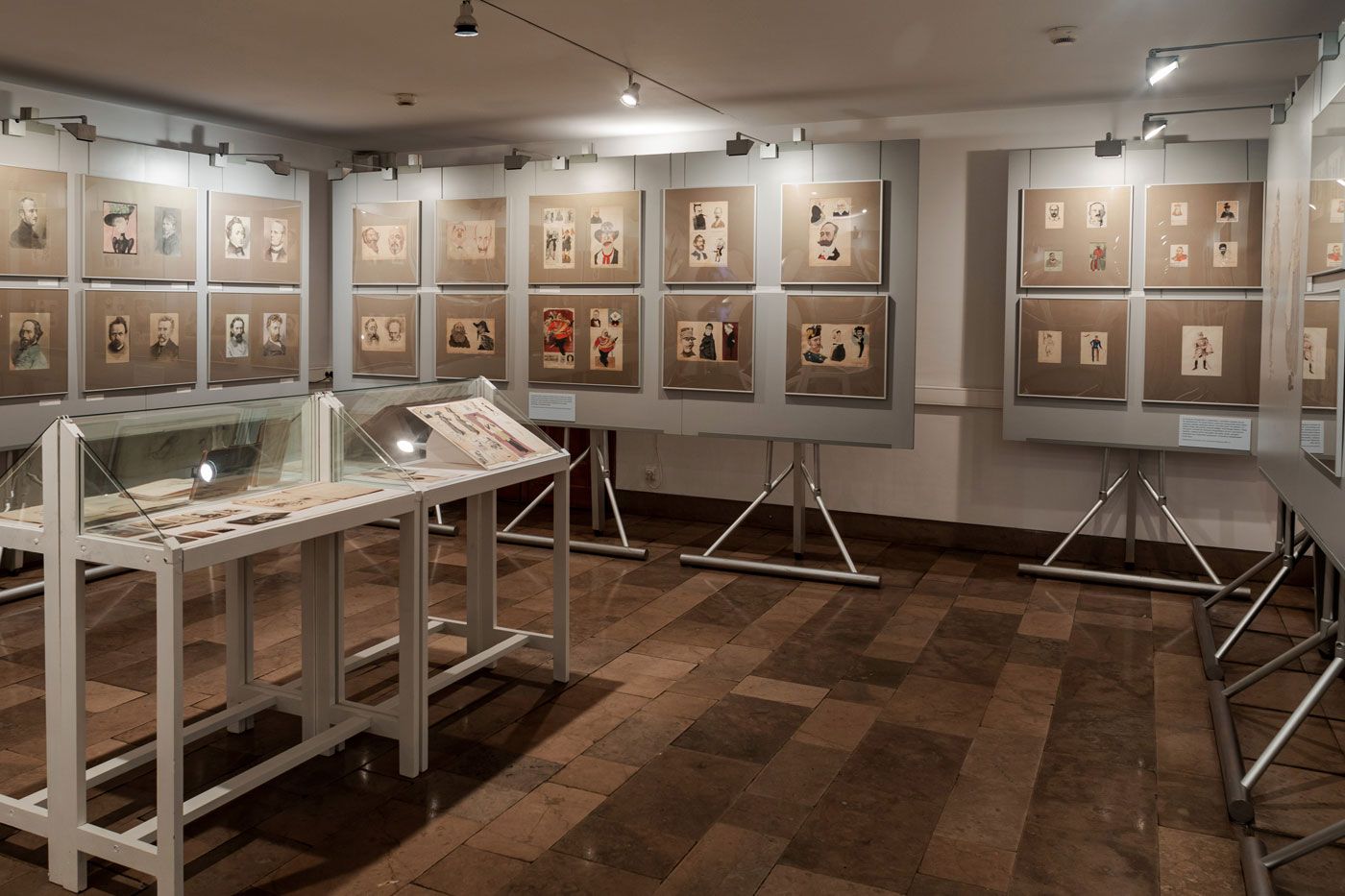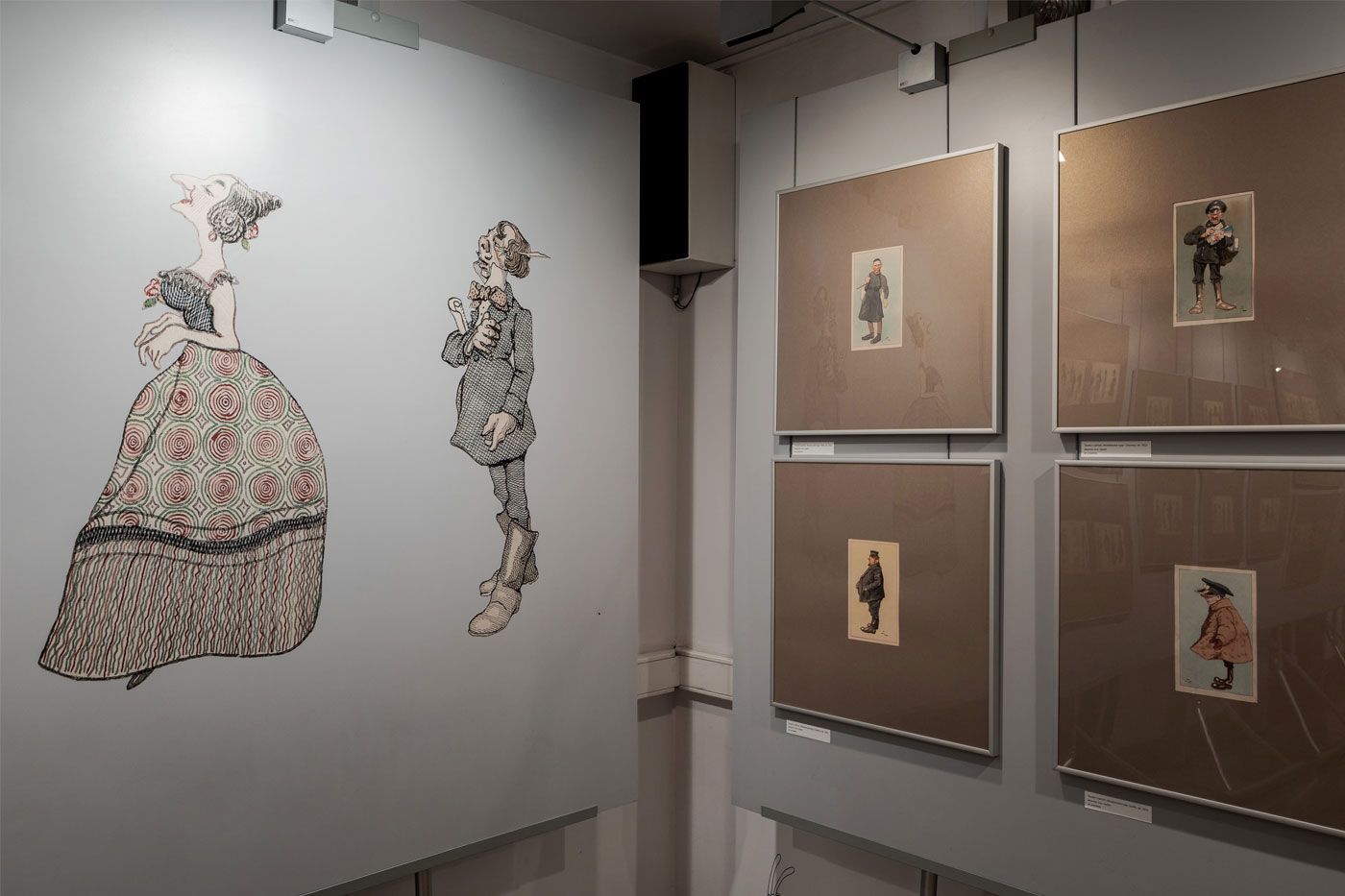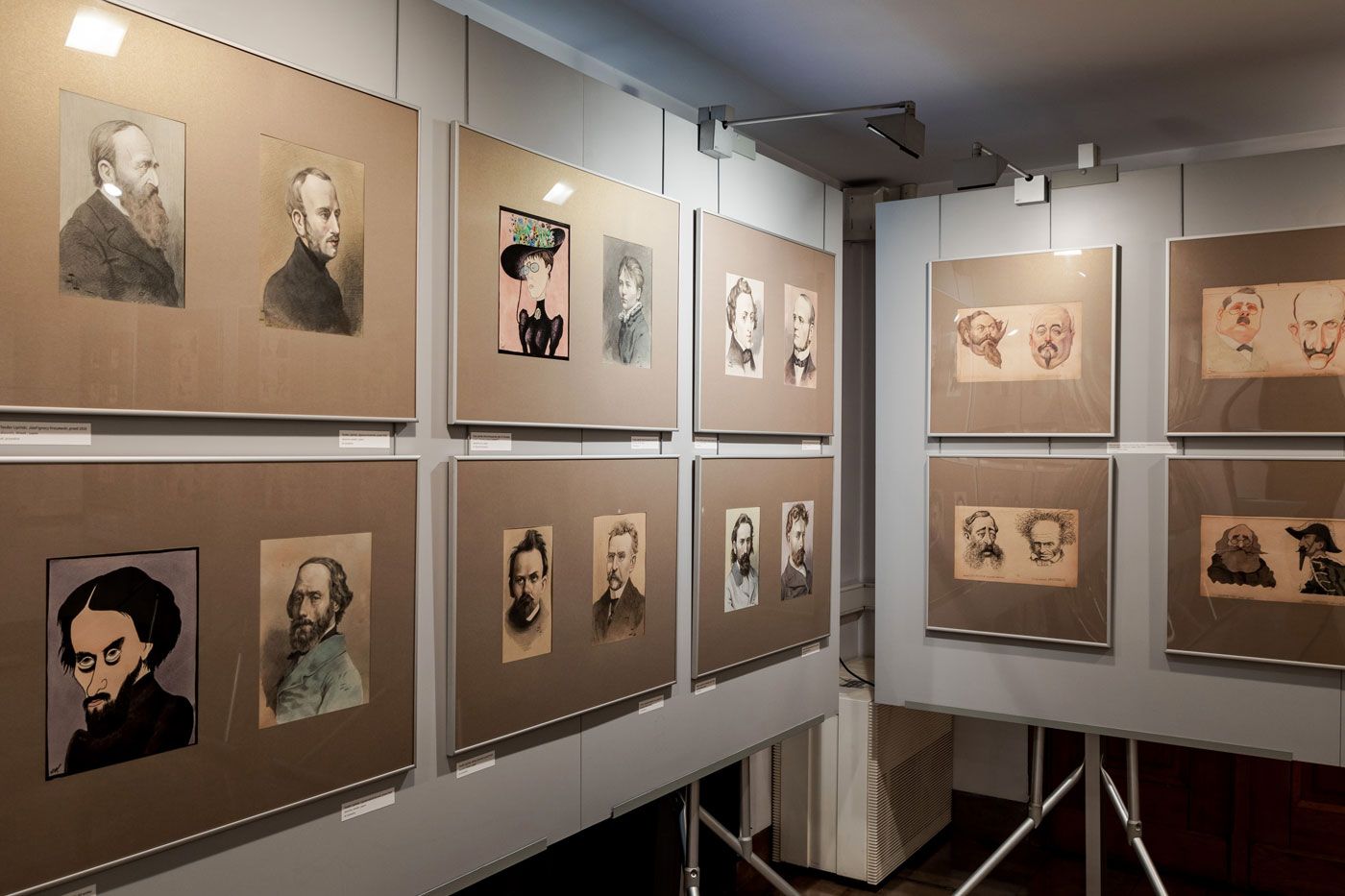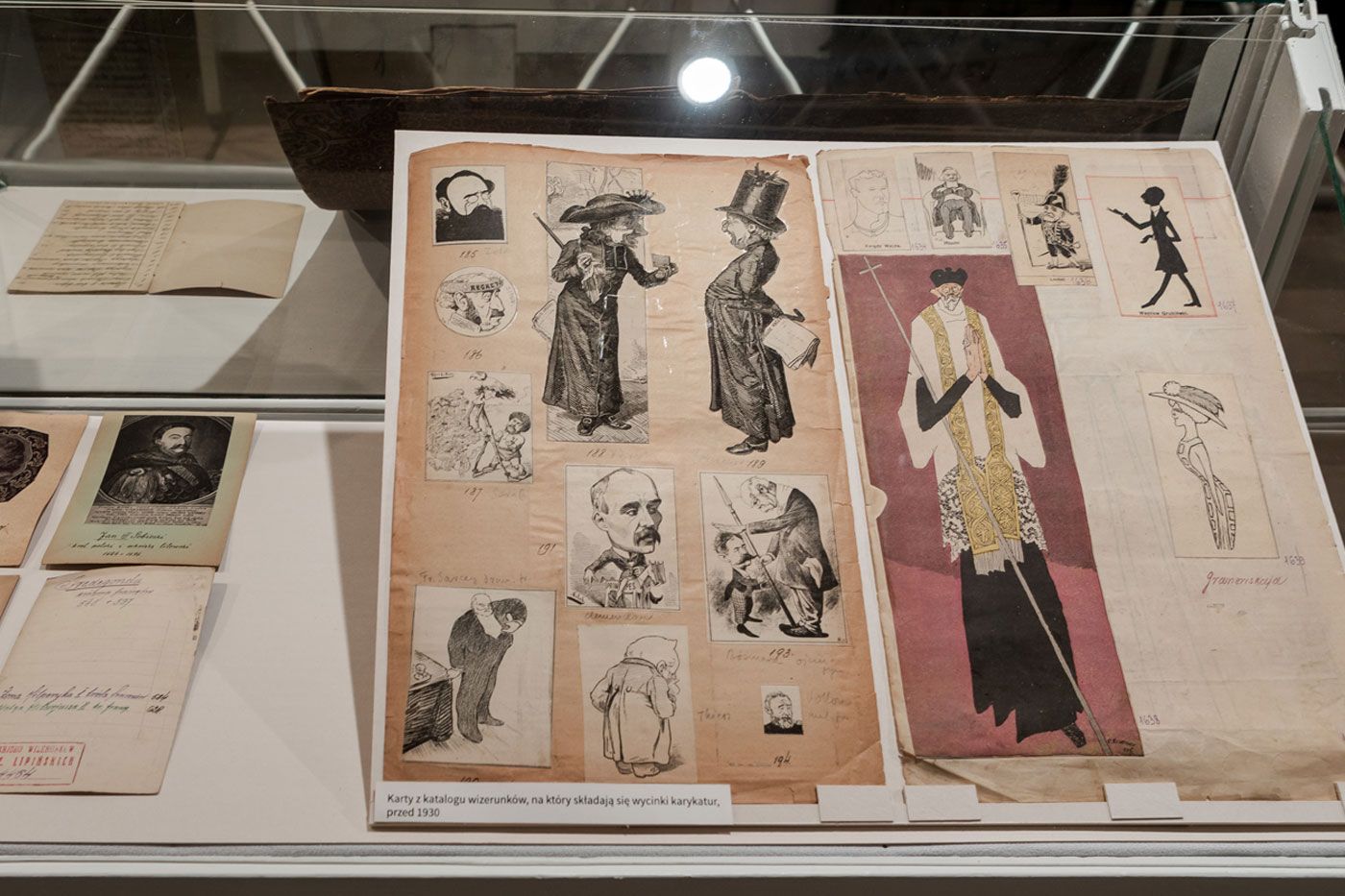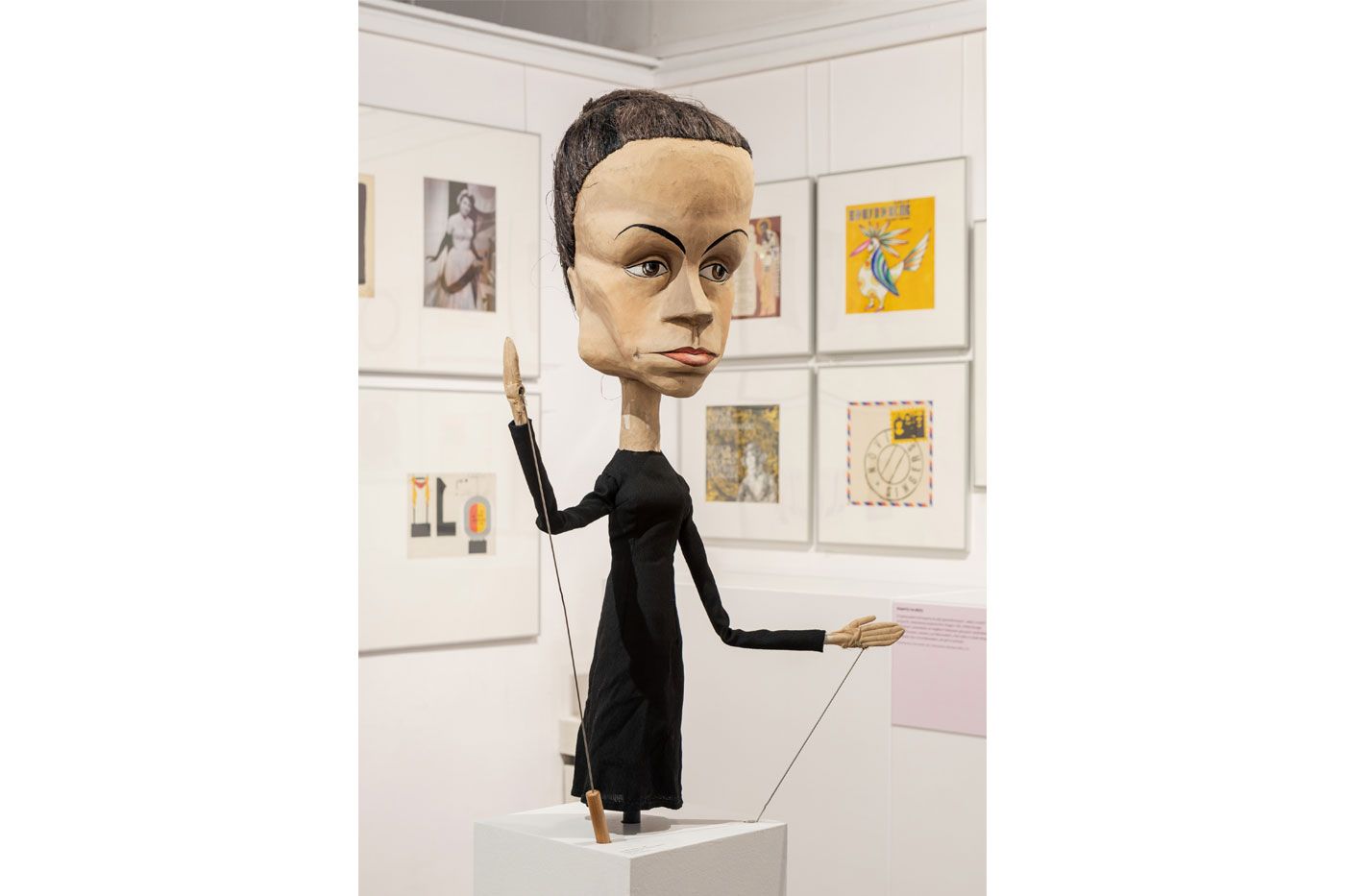Keep an eye
Teodor and Eryk Lipiński
I made a Design
Graphic designs by Eryk Lipiński
Teodor and Eryk Lipiński
Graphic designs by Eryk Lipiński
1 April – 18 June 2023
Museum of Caricature
In 2023, the Eryk Lipinski Museum of Caricature will celebrate its 45th anniversary. The focal point of the celebrations is the anniversary exhibition, which will consist of two simultaneous exhibitions dedicated to the founder and patron of the Museum of Caricature – Eryk Lipiński: Keep an Eye. Teodor and Eryk Lipiński and I Made a Project. Graphic Designs by Eryk Lipiński
Teodor i Eryk Lipińscy
Teodor and Eryk Lipiński, father and son, were bound not only by family ties, but also by artistic interests and a passion for collecting. In addition to being talented creators of caricatures and satirical drawings, they both took a keen interest in the history of this field of work. There are many more touchpoints and connections in the oeuvres of the two Lipińskis.
They both produced editorial illustrations, designed posters, magazine and book covers, created stage designs for theatres, and promoted organisations for artistic pursuits. Teodor’s passion, namely collecting press cuttings of caricatures by various illustrators, was later continued by Eryk and sparked the creation of the Museum of Caricature, in 1978.
Keep an Eye exhibition aims to highlight the points of intersection in the two Lipińskis’ creative outputs, based on selected works. Teodor’s artistic activity was undoubtedly an inspiration for Eryk. This is evidenced by the portrait gallery of Polish kings and princes, as well as portraits and caricatures of Polish writers produced by the two artists.
An important supplement to the exhibition is the part devoted to Teodor’s collecting passion: excerpts from files containing portraits of significant personalities, dating back to the late 19th century, and an album drawn in 1900–1915, entitled A hundred years (1815–1915) in masks, caricatures, portraits, charges, types and sketches.
Graphic designs by Eryk Lipiński
Throughout nearly six decades of his activity as an artist of graphic humour, Eryk Lipiński made sure that the widest possible audience could ‘experience’ his ability to see the amusing side of life. Eryk’s brilliant sense of humour, at times tinged with a small and usually harmless dose of mischief, permeated his entire output, be it illustration, design or satire. The most important realm in which his exceptional talents materialised were cartoons in their humorous and satirical form. However, Lipiński’s oeuvre is much richer and definitely extends beyond illustration. Eryk was a versatile graphic designer – he left behind hundreds of posters, book and magazine cover designs, dozens of illustrations, occasional prints and even, as few people know, several animated films based on his drawings. These somewhat forgotten works, only sporadically revisited and exhibited, constitute valuable material demonstrating how the language of the artist’s expression developed over the decades. It is in these projects that Eryk’s sensitivity to the present is noticeable. Lipiński’s graphic design, far more than his satirical drawings – controlled, as they were, by a rigid and precise convention, subordinating form to content – is a field combining his original style with new trends and directions emerging in 20th century art.
Painter, illustrator, caricature and portrait artist, active organiser of cultural life.
Born on 11 January 1872 in Zhytomyr, son of Dionizy and Julia née Podwińska. He attended a classical Gymnasium in Odessa. In 1905, he was involved in the revolutionary events in the Russian Empire.
In 1905–1906, he moved to Cracow to study at Józef Mehoffer’s studio at the Academy of Fine Arts.
Between 1907 and 1911, he worked for the Polish Social-Democratic Party of Galicia and Cieszyn Silesia as well as its press organ and publishing house Naprzód [Forward], where he was employed as an administrator. From 1909 to 1911, he headed the Art Department of the Party. In 1911, together with his wife Jadwiga née Czartoryska, and son Eryk, he settled in Nowy Sącz where he also organised cultural life by establishing theatre groups, choirs and workers’ orchestras. In the Lutnia Robotnicza [Workers’ Lute] Singing Association, Lipiński was a choir conductor and the orchestra’s kapellmeister.
In 1913, he moved to Moscow with his family. In 1917, he became Head of the 1st Department of the Liquidation Committee for the former Polish Kingdom at the Polish Commissariat, which was directly subordinate to the People’s Commissar of Education of the Russian Soviet Federative Socialist Republic. In his official role at the Department, he looked after the monuments, works of art and national memorabilia moved out of Poland by the Tsarist authorities during the Partitions. At the same time, he ran a Polish theatre based at the Polish House.
In 1921, the family returned to Poland and settled in Warsaw. Initially, Lipiński became the director of the revue theatre Polonia, and later worked at the Emigration Office. He was a member of the Social Democracy of the Kingdom of Poland and Lithuania and of the Polish Socialist Party, also sitting at the Management Board of the Workers’ University Society and the Board of the Warsaw Branch of the Society, where he served as treasurer. He passed away on 23 January 1932.
Between 1906 and 1915, his drawings were published in such magazines as Naprzód [Forward], Kropidło [Aspergillum], Promyk [Ray of Light], Prawo Ludu [People’s Right], Głos Narodu [Voice of the Nation], Czas [Time], Słowo Polskie [Polish Word], Nowiny [News], as well as Krivoe Zerkalo [Crooked Mirror] (Moscow). In 1927, the Pobudka [Wake-up] weekly magazine published excerpts from his diary dating back to the revolutionary period. He also authored publications in Gazeta Robotnicza [Workers’ Paper], Robotnik [Worker] and Niepodległość [Independence]. In his creative work, Lipiński focused mainly on portrait, moral and political caricature. His works include an album entitled A hundred years (1815–1915) in masks, caricatures, portraits, charges, types and sketches depicting well-known political figures and cultural personalities, as well as series of drawings entitled Polish Dolls and Moscow’s Dolls, presenting various human types. His portrait works include a series of representations of famous Poles (writers, painters, military commanders), Polish kings and princes, as well as family portraits. He also designed theatre decorations (e.g. the curtain for the theatre in Nowy Sącz). For many years, Lipiński collected caricatures and satirical drawings cut out from illustrated magazines and pasted into special albums. He also created a file of images of historical figures.
His works were displayed at the Anniversaries 86 exhibition at the Museum of Caricature, in 1986.
Teodor Lipiński’s art can be found in the collections of the Museum of Caricature, the National Museum in Warsaw, the Museum of Cracow, and the Library of the Ossoliński National Institute.
Caricaturist, graphic artist, satirist, columnist, author of posters and book illustrations, cabaret texts, books on the history of caricature, collector, commissioner of numerous exhibitions of posters and satirical drawings, founder of the Museum of Caricature.
Born on 12 July 1908 in Cracow, son of painter Teodor Lipiński and Jadwiga née Czartoryska. In 1913–1921, he lived with his parents in Moscow. After returning to Poland in 1921, his family settled in Warsaw where he attended the Joachim Lelewel Gymnasium, the 2nd Gymnasium in Warsaw, and Adam Rychtarski’s school. In 1934–1939, he studied at the Academy of Fine Arts in Warsaw: painting with Prof. Tadeusz Pruszkowski, applied graphic arts with Prof. Edmund Bartłomiejczyk, lettering and typography with Prof. Bonawentura Lenart and scenography at Prof. Władysław Daszewski’s studio.
He made his debut as a caricaturist in 1928, in the Pobudka [Wake-up] weekly magazine. In 1934, he designed his first cover for M. Arct’s Publishing House, and soon debuted as a poster artist (poster for the Exhibition of Soviet Photography). Around 1935, with Andrzej Rubinrot, he established a company designing covers for F. Hoesick’s Publishing House, ‘Mrówka’ and ‘Renaissance’ Publishing Institute.
In late 1935, together with Zbigniew Mitzner, he founded the satirical weekly magazine Szpilki [Pins] and designed its title vignette. In 1935–36, he served as the editor-in-chief of the magazine. In the late 1930s, he produced advertisements for such companies as ‘Pluton’, ‘Bracia Jabłkowscy’, ‘Pepeo’ while also designing exhibition stands and pavilions for the ‘Pluton’ company and the ‘Robotnik’ publishing house for the Poznań Fair (1937), among others. Between 1935 and 1939, he was a member of the ‘Czapka Frygijska’ [Phrygian Cap] Visual Artists’ Club.
During the Second World War, he was detained in the camps in Auschwitz and Pruszków, as well as prisons in Pawiak, Daniłowiczowska and Rakowiecka streets.
After the war, from 1945 to 1946, he was the artistic director of the ‘Czytelnik’ [Reader] publishing house. In 1945, Lipiński established a permanent collaboration with Polish Film and later Film Rental Centre, for which he designed film posters. As a poster artist, he also designed numerous theatrical, anniversary and political posters. In 1946, he became editor of the weekly magazine Szpilki’, which had reopened a year earlier. He held that position until 1953. Between 1956 and 1958, he was the artistic director of the monthly magazine Polska [Poland] and the weekly Zwierciadło [Mirror] (1957–1958).
As a cartoonist, illustrator and graphic designer, he collaborated with such magazines as Szpilki, Mucha [Fly], Przekrój [Cross-section], Karuzela [Merry-go-round], Literatura [Literature], Kurier Polski [Polish Courier], Polityka [Politics], Przegląd Kulturalny [Cultural Review], Polska [Poland], Panorama, Stolica [Capital], Świat [World], Świerszczyk [Little Cricket], Płomyk [Flame], Trybuna Ludu [People’s Tribune], Express Wieczorny [Evening Express], Zwierciadło [Mirror] and such publishing houses as ‘Czytelnik’, ‘Iskry’, ‘Wydawnictwo Poznańskie’, ‘Wydawnictwo Literackie’, ‘Wydawnictwo Lubelskie’, ‘Krajowa Agencja Wydawnicza’, ‘Instytut Wydawniczy PAX’, ‘Wydawnictwa Artystyczne i Filmowe’, ‘Wydawnictwo Artystyczno-Graficzne’, RSW ‘Prasa-Książka-Ruch’.
He also designed the artwork for exhibition stands and pavilions, e.g. for the Department of Demography and the Social Insurance Institution for the Exhibition of the Regained Territories in Wrocław (1948), for St. Erik’s Fair in Stockholm (1955), for the Industrial Exhibition in Beijing (1961), as well as for international fairs and exhibitions in Izmir (1954), Paris (1962) and Casablanca (1963–64).
As a stage designer, he worked with the Satirical Theatre (1952), the Ateneum Theatre (1958), and the Syrena Theatre (1957–1964). He developed set design for such TV shows as ‘Miks’ (1963) and ‘Delikatesy’ (1965). In 1965–1975 he collaborated with the ‘Dudek’ cabaret as a writer and a designer of stage decorations, posters, leaflets and programmes.
In 1966, he was one of the initiators and commissioners of the 1st International Poster Biennale in Warsaw.
In 1978, he founded the Museum of Caricature and became its curator and then director. Eryk Lipiński
headed the Museum until 1991. In 2002, the Museum of Caricature was named after him. In 1987, he initiated the Association of Polish Caricature Artists and served as its president. He was a member of the Polish Workers’ Party (PPR) and later of the Polish United Workers’ Party (PZPR).
In his private life, he was married to Anna Gosławska-Lipińska (alias Ha-Ga) – cartoonist, illustrator and graphic artist, and later to Maria Lipińska née Borowicz. Father of Zuzanna Lipińska – illustrator, graphic artist and designer, graduate of the Academy of Fine Arts in Warsaw, and Tomasz Lipiński – musician and composer.
In 1991 he was awarded the title of Righteous Among the Nations.
He passed away on 27 September 1991, in Warsaw.
curator and author of the exhibition scenario: Piotr Kułak
collaboration: Zuzanna Lipińska, Tomasz Lipiński
framing of the works: Leszek Mozolewski
design of scenographic elements: Artomontage
catalogue design: Zuzanna Lipińska


